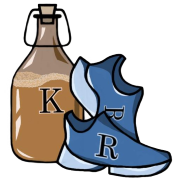In my last post, I talked about the three key pillars of fitness: cardio (for me, primarily running), nutrition, and strength training. While running and nutrition have always been my focus, strength training has been the one area I’ve historically neglected. A quick glance at my bookshelf confirms it—I’ve got stacks of books on running, plenty on nutrition, but not a single one dedicated to building muscle or resistance training. It’s just never been my passion.

I know some people are the complete opposite—they thrive in the gym, love lifting weights, and dread cardio. That’s never been me. But I can’t ignore the benefits of strength training, especially as I work to improve my running performance and stay injury-free.
A Look Back: Strength Training and Peak Performance
I remember back in the early 1990s when Arnold Schwarzenegger served as the U.S. fitness champion. He emphasized the importance of balancing cardio with strength training. At the time, that advice probably went in one ear and out the other. But as I look back on my best race performances, I realize strength training played a bigger role than I gave it credit for.
In 2009, I had my fastest year ever. I set personal records (PRs) in the 5K, half marathon, and full marathon. I was 38 years old, in peak condition, and running my best times. What was different that year? I was strength training consistently—two to three times a week.
My routine included upper body exercises like curls, bench presses, core work with crunches and push-ups, and lower body movements like squats, leg curls, and deadlifts. It wasn’t my favorite part of training, but the results spoke for themselves.
The Reality Check: Falling Off the Wagon
Like many runners, I’ve had stretches where I stuck to strength training and others where I let it slide. When I skip it, I notice the difference. I can still run, but if I try to ramp up my mileage or intensity, injuries creep in—Achilles tendonitis, hip pain, calf tightness, and even nagging lower back issues. My body reminds me that I can’t ignore strength work if I want to keep running at a high level.
Beyond performance, strength training is a crucial tool for injury prevention. As I’ve gotten older, it’s become even more apparent. Without it, my body just doesn’t hold up the way it used to.
Strength Training and Aging: A Fair Comparison
One of my favorite tools on *Runner’s World* is their age-grading calculator. It allows you to compare race performances at different ages to see how they stack up. My half marathon PR at 38 was 1:27:30. More recently, at 52, I ran a half marathon in 1:38:00—over 10 minutes slower. Initially, that felt discouraging, but after plugging the times into the calculator, I realized they were actually very similar in age-adjusted performance.
The problem? Boston Marathon qualifying standards have gotten tougher. Since I last qualified, the time standards have dropped by 15 minutes. If I want to make another run at Boston, maintaining my current fitness level isn’t enough—I need to improve.
The Commitment: Back to Strength Training
So, I’m making a change. I just joined a new local gym Turbo Metabolic Training and have committed to strength training twice a week. The added financial investment is a little motivation in itself—if I’m paying for it, I better show up. Even better, these are structured classes led by Jason Lee who is a certified strength and conditioning specialist, which means I’ll have great coaching on my journey.
My goal? To see if I can get faster than ever before.
Over the next few months, I’ll be monitoring my progress, building my running base, and refining my training plan. I haven’t picked my next goal race yet, but that’s coming soon. Stay tuned—I’ll be sharing updates as the year unfolds.

Leave a Reply
You must be logged in to post a comment.